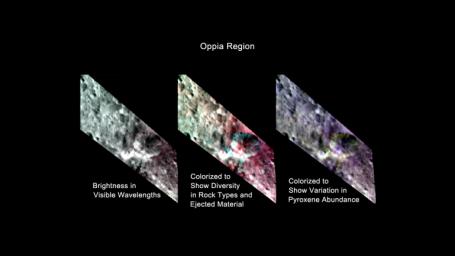
|
Oppia Region, Three Ways
- Click the image above for a larger view
- Full-Res JPEG (1280 x 720) (58.8 kB)
- Full-Res TIFF (1280 x 720) (2.8 MB)
Caption:
This image from NASA's Dawn mission shows three colorized views of the Oppia region in the southern hemisphere of the giant asteroid Vesta. These views, made from data obtained by Dawn's visible and infrared mapping spectrometer, reveal the variations in the region's brightness and mineralogy.
The image on the left shows brightness variations in visible wavelengths. The image in the middle, which assigns colors to different infrared wavelengths, shows the diversity of rock types and the large amounts of ejected material around the crater. The image on the right, which assigns colors to a different pattern of infrared wavelengths, shows the variation in the abundance of the mineral pyroxene, an iron- and magnesium-rich mineral. Green indicates a greater concentration of pyroxene and violet indicates less.
These images were obtained in August 2011, from an average of 1,700 miles or 2,700 kilometers above the surface.
Background Info:
The Dawn mission to Vesta and Ceres is managed by NASA's Jet Propulsion Laboratory, a division of the California Institute of Technology in Pasadena, for NASA's Science Mission Directorate, Washington. UCLA is responsible for overall Dawn mission science. The visible and infrared mapping spectrometer was provided by the Italian Space Agency and is managed by Italy's National Institute for Astrophysics, Rome, in collaboration with Selex Galileo, where it was built.
More information about Dawn is online at http://www.nasa.gov/dawn and http://dawn.jpl.nasa.gov .
Cataloging Keywords:
| Name | Value | Additional Values |
|---|---|---|
| Target | 4 Vesta | |
| System | Main Belt | |
| Target Type | Asteroid | |
| Mission | Dawn | |
| Instrument Host | Dawn | |
| Host Type | Orbiter | |
| Instrument | Visible and Infrared Spectrometer (VIR) | |
| Detector | ||
| Extra Keywords | Color, Crater, Infrared | |
| Acquisition Date | ||
| Release Date | 2012-05-10 | |
| Date in Caption | ||
| Image Credit | NASA/JPL-Caltech/UCLA/INAF | |
| Source | photojournal.jpl.nasa.gov/catalog/PIA15670 | |
| Identifier | PIA15670 | |
